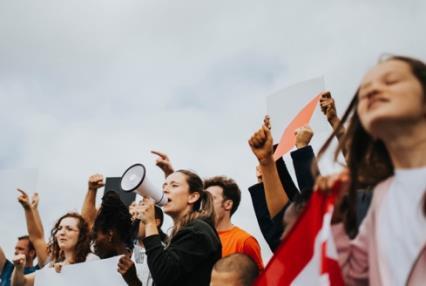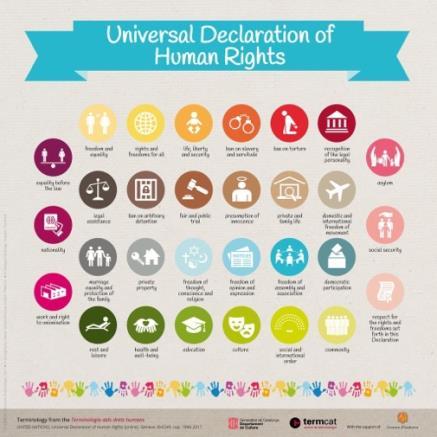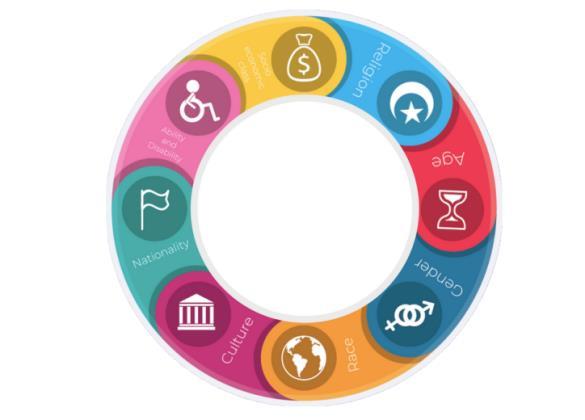LESSONPLAN
Learn how people exercise their human rights every day, how the rights for marginalized communities are not always protected, and how youth can protect human rights with guidance from the United Nations Sustainable Development Goals.

Explore the United Nations Declaration of Human Rights and the Sustainable Development Goals as anchors for how people around the world come together to fight human rights violations. With unique features including student vlogs about human rights in their countries and tips for taking concrete actions, youth learn about humanity, interconnectivity, and how they can work together toward a better future.
About Global Nomads Group
For over 25 years, Global Nomads Group has leveraged technology to host digital safe spaces for young people around the world to share their stories, challenge assumptions, engage with and learn from each other, and, by doing so, foster a more just world.
Copyright © 2023 by Global Nomads Group. All rights reserved.

HUMANRIGHTS Module1
Objectives
By the end of this module, students will:
1. Examine the human rights they practice daily.
2. Understand the concept of human rights and the United Nations Declaration of Human Rights.
3. Explore global human rights violations.
Introduction
Ask the students if they use social media platforms like Instagram and if they have ever thought about the consequences of their posts.
Prompt the students with the question:
1. Should people be able to post online without legal repercussions?
Allow for discussion time.
Human Rights

• Define the term “human rights” and ask students to give examples of human rights.

HUMANRIGHTS Module1
• Introduce the Universal Declaration of Human Rights (UDHR) (https://www.un.org/en/about-us/universal-declaration-of-human-rights) and provide copies to each student. You can also project it to your class.
• Ask students to read through the UDHR and identify the human rights that they think are most important.
• Discuss the students' choices as a group and ask them why they think these rights are important.
Human Rights Violations
• Define the term “human rights violations” and ask students to give examples of human rights violations.
• Show the image of the map of the world with the red arrow pointing to North Korea and explain the human rights violations that occur there.
• Ask students if they can think of any other examples of human rights violations and who they were performed by.
• Discuss the impact of human rights violations on individuals and societies.
Conclusion
Recap the main points of the lesson and ask students to share one thing they learned.
Ask students to reflect on the following question:
1. What have you learned about human rights in other countries than your own?
Explore
Show the students the map, and explore the stories, articles, and videos that have been provided by their global peers. Ask the youth to pick their top three stories, and share them with their peers.

HUMANRIGHTS Module1
Share
Students will answer the following prompts:
1. Think about the human rights in the Universal Declaration of Human Rights
2. Consider what rights you practice each day.
3. Think specifically about a time in the past week when you used your human rights. It could be an everyday action or an action that took courage and conviction.
4. Imagine it was taken away from you. How would you feel?
At the end of their stories, students should mention 2-4 stories and resources they've explored and would recommend to their global peers.

HUMANRIGHTS Module2
TRIGGER WARNING: Honor Killings
Objectives
By the end of this module, students will:
1. Reflect on the ways that marginalized people are denied human rights.
2. Understand the differences between equality, equity, and justice.
3. Explore how communities fight for justice.
Introduction
• Introduce the text exchange screenshot and have students read through it.
• Ask them if they think the situation in the screenshot is fair or unfair.
• Discuss their answers and relate it to the concept of human rights.
Video
Show the video about the experiences of marginalized teenagers around the world.
After watching, have students discuss the following questions:
1. What were some of the challenges faced by the teenagers in the video?
2. How did their identities shape their experiences?
3. How did they overcome these challenges?
Marginalized Groups
• Explain the concept of marginalized communities and have students identify different marginalized groups in society. Discuss the factors that contribute to marginalization.
• Show the images depicting equality, equity, and justice concepts and explain the differences between them (images are available in the course’s platform).

HUMANRIGHTS Module2
• Have students give examples of each concept and how they can be applied to promote fairness in society.
Equality, Equity and Justice
• In groups, have students identify a social issue that affects a marginalized group and come up with a plan to promote fairness using the concepts of equality, equity, and justice.
• Have each group present their plan to the class and lead a class discussion on how to promote fairness for marginalized communities.
Explore
Show the students the map, and explore the stories, articles, and videos that have been provided by their global peers. Ask the youth to pick their top three stories, and share them with their peers.
Share
Show your students the Identity Community Wheel:

Using the Identity Community Wheel we've provided, ask your students to answer these questions in reference to the eight characteristics that affect your human rights:

HUMANRIGHTS Module2
1. What characteristic from this wheel do you think impacts you the most daily?
2. What characteristic from this wheel do you think impacts your community the most?
3. What characteristics from this wheel do you have that your community values?
4. What is one characteristic from this wheel that you would like your community to learn more about? Why do you think it is important?
At the end of their stories, students should mention 2-4 stories and resources they've explored and would recommend to their global peers.
Extension Activities
1. Research different marginalized groups and their experiences with human rights in different parts of the world
2. Interview someone from a marginalized community and ask them about their experiences with human rights and discrimination
3. Watch and analyze a movie or documentary about human rights and marginalized communities

HUMANRIGHTS Module3
Objectives
By the end of this module, students will:
1. Consider the United Nations’ Sustainable Development Goals (SDGs) and their relationship to human rights.
2. Understand the differences between equality, equity, and justice.
3. Explore the interconnectivity of the SDGs.
Introduction
Discuss with your students the following:
1. Can you think of some human rights that are protected in your country, but are not protected in others?
2. Are there any human rights that your country does not protect that are protected in other countries?
3. Are there human rights that are protected for some people in your country but not for others?
Explain that human rights are rights inherent to all human beings, regardless of their nationality, place of residence, sex, ethnicity, religion, language, or any other status. Explain that protecting human rights is essential for creating a fair and just world.
Human Rights Worldwide
• Ask your students to research and identify one human right that is protected in their country but not protected in others. Have everyone share their findings with the class.
• Facilitate a discussion on why human rights are not protected equally in all countries and how we can work to create a more just world.

HUMANRIGHTS Module3
Enforcing Human Rights
• Discuss the difference between declarations and conventions, and how they are used to protect human rights.
• Show your students the video of the Convention on the Rights of Persons with Disabilities as an example of a UN treaty designed to protect human rights.
• Ask students why they think it's important for treaties to be legally binding. (Or just discuss this, they might not know.)
• Facilitate a discussion on how we can work to enforce human rights and ensure that they are protected for all people.
SDGs
• Present all 17 SDGS (https://www.undp.org/sustainable-development-goals) to students and go through them all. You can either provide copies of the document or project it onto a wall/board.
• Explain to students that the United Nations' Sustainable Development Goals are a group of global goals adopted by all member states of the UN in 2015 as a universal call to action to end poverty, protect the planet, and ensure that all people can enjoy peace and prosperity.
• Ask students to explore and read about a few of the SDGs, and discuss which goals they think are most important for ensuring human rights are protected.
• Have students reflect on what they can do to help achieve the SDGs and protect human rights in their own communities and beyond.
Explore
Show the students the map, and explore the stories, articles, and videos that have been provided by their global peers. Ask the youth to pick their top three stories, and share them with their peers.

HUMANRIGHTS Module3
Share
Students will answer the following prompts:
1. Think of someone your age who lives in a different country from you.
2. Write a letter to that person (they can be someone you actually know or someone you have read about) explaining what the SDGs are/why they are important and then focus on one SDG that you are passionate about.
3. Tell your peer why this matters to you so much and how it connects to human rights.
At the end of their stories, students should mention 2-4 stories and resources they've explored and would recommend to their global peers.

HUMANRIGHTS Module4
Objectives
By the end of this module, students will:
1. Explore and design action plans for supporting human rights individually, locally, and globally.
Introduction
Start by recapping what students have learned so far about human rights. Remind them of the importance of taking action to fight for human rights for all.
Video: The World Needs: Humanitarian Relief
• Ask students to watch the video: “The World Needs: Humanitarian Relief.”
• Ask students:
o How can we make sure that we actually follow through and do something about human rights violations and injustices?
• Facilitate a discussion about the many ways we can do something about rights violations
Taking Action
Introduce the concept of SMARTIE goals. Explain the meaning of each letter in the acronym and what it entails.
A Smartie Goal should be:
S - Specific: Reflects a concrete, definable goal that you seek to accomplish, connected to a broader values-based purpose. Guiding Questions: What specifically do you want to do? Is the purpose of your goal clear? What is your desired result?

HUMANRIGHTS Module4
M - Measurable: Includes clear measures that show whether the goal has been reached (in numbers or a measurable change). Guiding Questions: How will you measure your progress? How will you know when you have achieved your goal?
A - Ambitious: Challenging enough that reaching the goal will make a difference in people’s lives. Guiding Questions: Is your goal aligned with the issue? Is your goal challenging enough? Is your goal meaningful and relevant? Why does your goal matter? What makes attaining this goal important?
R - Realistic: Something you can actually accomplish. Guiding Questions: Is this goal within your power to accomplish? Do you have the resources you need to accomplish your goal? Do you have access to the contacts, support, training, facilities, education, skills that your goal requires?
T - Time-bound: Includes clear deadlines. Guiding Questions: When exactly do you want to accomplish this goal? What time frame do you need to reach your goal? When will your goal be achieved and at what pace?
I - Inclusive: The goal brings people who are directly affected, particularly those most impacted, into reaching the goal. Guiding Questions: Are all the people affected accounted for in your goal? Does it bring in traditionally marginalized people? How can you make your goal be inclusive towards/positively impact people from marginalized groups? Is your goal taking a diverse universe into consideration?
E - Equitable: Seeks to address injustice, inequity, and oppression. Guiding Questions: Does it seek to address systemic injustice, inequity, or oppression? How can you adapt your goal so that it actively and intentionally seeks to promote equity and limit the disparity of access to resources? How can you make your goal purposefully seek to share power amongst groups?

HUMANRIGHTS Module4
Explore
Show the students the map, and explore the stories, articles, and videos that have been provided by their global peers. Ask the youth to pick their top three stories, and share them with their peers.
Share
Students will answer the following prompts:
1. Ask each group to come up with a SMARTIE goal related to human rights.
2. Have each group present their SMARTIE goal to the class.
3. After each presentation, ask the class to provide feedback on whether the goal is specific, measurable, ambitious, realistic, time-bound, inclusive, and equitable.
4. Encourage students to give constructive criticism and suggestions for improvement.
At the end of their stories, students should mention 2-4 stories and resources they've explored and would recommend to their global peers.
Extension Activity
Encourage students to take action towards achieving their SMARTIE goals for human rights. They can join a youth organization that focuses on human rights, raise awareness on social media, or speak up against human rights violations they witness in their communities.

